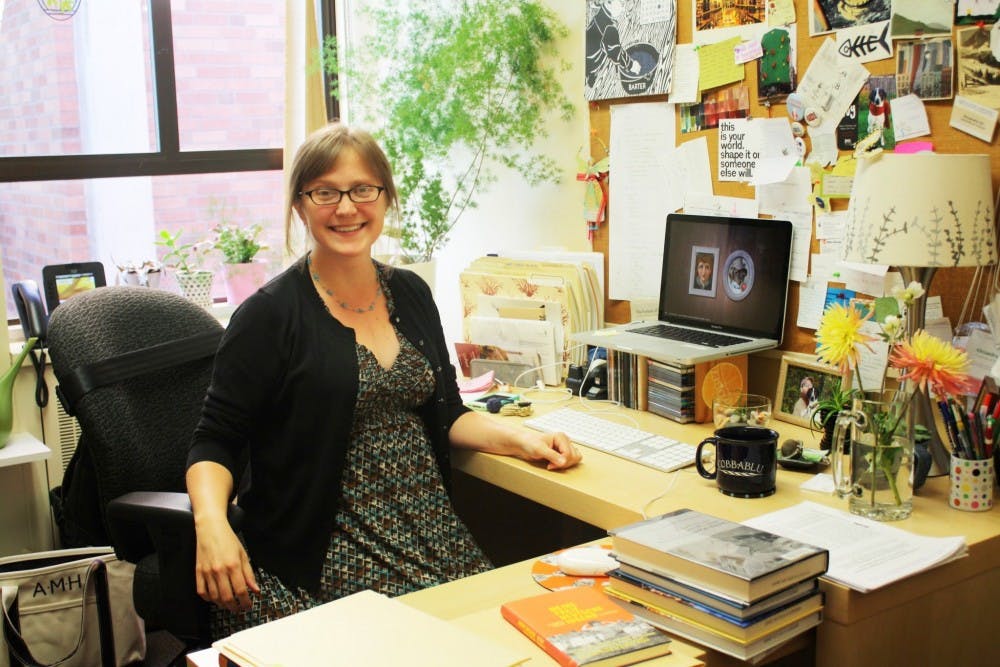By Olivia Alsept-Ellis|
You see the artifacts in their offices every visit. You want to ask about the Star Wars X-Wing fighter and the garden gnome but don’t want to come across as nosy. But the questions don’t stop plaguing you. Why does he keep a toilet brush in his office?
Some professor’s offices look like scholarly sanctuaries while others are more sterile and focused. However, all of them carry special artifacts with interesting stories attached.
And perhaps the best thing about the stories behind the asparagus plants or Alexander Pope is being reminded that professors aren’t just teachers, but highly creative and intriguing people. The complexity of their environment is evidence of their individuality.
Five professors from different departments share the stories behind their beloved clutter.
Plato and postcards
Alejandro Santana, philosophy
The philosophy books that circumnavigate philosophy professor Alejandro Santana’s room are only slightly overwhelming.
“I have a lot of books because I love them all. I can’t just pick a favorite book of my entire shelf,” Santana said. “They are all so interesting.”
The books are divided by major philosophical section, from Latin American philosophy to Ancient Greek. The books ranged from the giant and glossy to the thin and tearing. A matching collection of miniature and wearing books looked especially precious and important.
“Those are Plato’s and Aristotle’s works in both English and Greek,” Santana said. “You can actually read along in the Greek to see how it was translated. Reading [Plato and Aristotle] in the Greek is far richer than the translation.”
Despite the extreme amount of books, his office felt nothing like a concentrated library.
“I need my office to be a place that I actually enjoy going to. I don’t want to feel like ‘Oh God, I’m going to die’,” said Santana.
To maintain the humanity of the office are pictures of his children, goddaughter and other family members up above his computer. From the guest seat, it’s a blur of smiling faces. Another face smiles down, but it’s an eagle mask from the bookshelf.
“I don’t think this one has any significance but it does for me. It reminds me of the Eagle and Jaguar Warriors, the two Aztec military orders,” said Santana. “I just like to think about them, sometimes.”
Next to his desk is a wall covered in dozens of postcards.
“I can actually say that I’ve seen all of these things, all the artwork and places, with my own eyes. With the exception of that one.”
Surrounded by the Klimt artwork, Mozart portraits and European landscapes, the one small postcard that he hasn’t seen is like one last “To Do” left on a largely completed list. On the door are other postcards from Central and South America—the same rules apply, he’s seen them as well.
“I think if I had to work in a sterile cubicle where I couldn’t keep any of my stuff it would kill me,” he said.
The home of a bibliophile
Herman Asarnow, English
English Professor Herman Asarnow’s office defies the space-time continuum because it feels as if one has been transported to 17th century Great Britain. If ever there was a concentrated library, it was this space.
His students can’t help but notice his space resembles the controlled chaos of bibliophile.
“The amount of books can be pretty daunting,” senior English major Leah Becker said. “When you’re in his office, he’s constantly looking around and grabbing [books] off the shelves for you. But it’s like, he actually reads them! It isn’t just this Beauty and the Beast fairy tale library. I hope to have a personal library like it someday.”
While his books varied from the ancient to the contemporary, there is one distinct theme that reappears: his room is essentially a functioning archive of Alexander Pope.
“I only have three [framed] pictures of Alexander Pope,” he says. Only three.
Alongside Pope’s dreamy gazes are other framed portraits that, to an untrained eye, would appear exactly the same. Luckily, Asarnow was at the ready to train.
“They’re all different kinds of engravings. Line engravings, copper plated,” Asarnow said. “When they changed to steel plate at the very end of the 18th century the quality is not nearly as interesting. About five of copies of those engravings are also in the national portrait gallery in London.”
Much like the engravings, no small token in Asarnow’s office can escape an intricate explanation. Casually resting alongside collections of Shakespearean sonnets was a toilet brush.
“Well that’s because in class I said, ‘C’mon guys, this is poetry, it’s not cleaning toilets!’,” Asarnow said. “At the end of the semester, they gave it to me as gift!”
Close to his desk are pictures of a sweet faced, snow-white Scottie dog with a photogenic flair.
“His name is Boswell, named after James Boswell. Scottish Dog and he’s a Scottish writer.”
Another pet rests above the door: a toy moose head. And it’s wearing reading glasses.
“It’s an ironic commentary on the longhorns in Dr. Orr’s office,” Asarnow said. “Also, in case I forget my glasses.”
Visual space for an artists and gnomes
Gregory Pulver, fine and performing arts
Fine and performing arts professor Gregory Pulver turned a classic office space into a studio room.
“I’m a visual person,” Pulver said. “I need a visual space. It needs to be very open too, if I’m going to work well here.”
Strategic decorations break up the white walls, adding an element of electricity without being overbearing.
“I wanted it to be a room from my house and a part of me because I spend almost more time here than at home,” said Pulver.
The showcased items of Pulver’s office definitely hold a mirror to him. The preserved and mounted butterfly matches his entomological tattoo, and the eye catching gnomes in the left corner of the bookshelf are as endearing as his well kept moustache.
“I’ve always been a fan of gnomes and I have a collection to match at home,” Pulver said.A giant blue and purple hat resting casually on the back wall captures the spirit of Pulver’s office: casual and, perhaps unintentionally, funky.
“An office shouldn’t feel intimidating,” Pulver said. “Students should feel comfortable and even inspired.”
A home for legos and computer science
Andrew Nuxoll, Computer Science
Computer science professor Andrew Nuxoll’s office seemed sterile until the tiny details that made this room distinctly his began to reveal themselves. The tiny Lego figurine above his computer clues the visitor into the uniqueness of his space.
“He’s an old school computer programmer, like me,” said Nuxoll.
Nuxoll’s office maintains a quirky attitude, though he wouldn’t admit it was intentional. On the left wall is a white board with computer programming language written on it, letters and numbers which are completely devoid of meaning to non-computer programmers. But sitting just on top of it is a collection of miniature items. A tiny X-Wing fighter (from Star Wars) hangs out with a tiny spider man.
“I just collected this stuff when it occurred to me,” Nuxoll said. “It’s all special but not super important. Most of what I keep in the office is going to be work stuff. I don’t really take it home, I like to keep it here.”
While the papers scattered on the desk would confirm that Nuxoll’s office is primarily a place of work, the stacks of board games would have to disagree.
“I’m a computer science professor so I program all the time, even if I’m doing it for fun or for research,” said Nuxoll, “but I play computer games from time to time. My favorite tactical game is called Empire. My favorite role play kind of game is called Plainscape: Torment. It used the dungeons and dragons second edition rules from way back in the day but is generally regarded among gamers as one of the best, if not the best, story in a game.”
The home of vivacious asparagus
Alexandra Hill, German
A casual visitor to German professor Alexandra Hill’s office would be hard pressed to guess the name of the shaggy needled plant that lives in the corner.
“I’m very attached to this plant. It’s older than I am,” Hill said. “My husband hates it because he’s pretty sure it will come alive one day. It just won’t die. I’ve left it for months and it’s been moved a lot. I think if it were to suddenly die, my days would be numbered. We’re totally connected at this point.”
It took a botanist before Hill discovered the species.
“I always thought it was an asparagus fern. But it turns out that it’s actually just asparagus,” Hill said. “Dr. Taylor told me that. It’s just asparagus in my office, not a fern.”
Students find Hill’s room a comforting landscape.
“I would say the room is very cozy,” said Senior Marketing and German major Matt Rosales. “I’ve always felt very welcomed. It’s like she’s definitely not going to yell at you, not in that room.”








